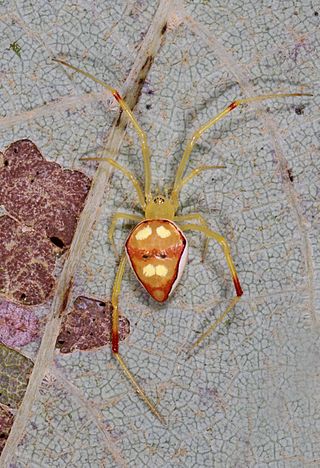
The Mygalomorphae, or mygalomorphs, are an infraorder of spiders, and comprise one of three major groups of living spiders with over 3000 species, found on all continents except Antarctica. Many members are known as trapdoor spiders due to their creation of trapdoors over their burrows. Other prominent groups include Australian funnel web spiders and tarantulas, with the latter accounting for around one third of all mygalomorphs.

The Pholcidae are a family of araneomorph spiders. The family contains more than 1,800 individual species of pholcids, including those commonly known as cellar spider, daddy long-legs spider, carpenter spider, daddy long-legger, vibrating spider, gyrating spider, long daddy, and skull spider. The family, first described by Carl Ludwig Koch in 1850, is divided into 94 genera.

The Goliath birdeater belongs to the tarantula family Theraphosidae. Found in northern South America, it is the largest spider in the world by mass and body length, and second to the giant huntsman spider by leg span. It is also called the Goliath tarantula or Goliath bird-eating spider; the practice of calling theraphosids "bird-eating" derives from an early 18th-century copper engraving by Maria Sibylla Merian that shows one eating a hummingbird. Despite the spider's name, it rarely preys on birds.

Latrodectus variolus, the northern black widow spider or northern widow, is a venomous species of spider in the genus Latrodectus of the family Theridiidae. The population is closely related to the southern black widow, Latrodectus mactans, and the western black widow, Latrodectus hesperus, of the genus.

Sphodros is a genus of North American purseweb spiders first described by Charles Athanase Walckenaer in 1835. It was considered a synonym of Atypus until 1980.

Sphodros rufipes, sometimes called the red legged purseweb spider, is a mygalomorph spider from the southern United States, though it has been photographed as far north as Indiana, Missouri, New Jersey, Minnesota, Tennessee, Delaware, Louisiana, and Tuckernuck Island in Massachusetts [West Virginia]. A recent sighting shows that these spiders can also be found in Canada. Recent sighting also in Kansas.

Sphodros niger, the black purse-web spider, is a mygalomorph spider from the Eastern United States. It is listed as a special concern species in Connecticut.
S. niger is an abbreviation of a species name. In binomial nomenclature, the name of a species is always the name of the genus to which the species belongs, followed by the species name. In S. niger, the genus name has been abbreviated to S. and the species has been spelled out in full. In a document that uses this abbreviation, it should always be clear from the context which genus name has been abbreviated.

Acrossus rufipes, the night-flying dung beetle, is a species of scarab beetle. It was first recorded by the zoologist Carl Linnaeus as Acrossus rufipes in his 10th edition of Systema Naturae. The species was more recently considered a member of the genus Aphodius, but is now again classified as Acrossus rufipes.
Sphodros atlanticus is a species of spiders from the family Atypidae. It was described by Willis J. Gertsch and Norman I. Platnick in 1980. The species was described from specimens found in Georgia, North Carolina, Virginia and Illinois. It has also been found in Maryland and Alabama.
Sphodros fitchi is a species of purseweb spider in the family Atypidae. It is found in the USA.
Tetragnatha guatemalensis, the Guatemalan long-jawed spider, is a species of long-jawed orb weaver in the family Tetragnathidae. It is found in North, Central America, Cuba, and Jamaica.

Antrodiaetus hageni is a species of folding-door spider in the family Antrodiaetidae. It is found in the United States.
Pachygnatha tristriata is a species of long-jawed orb weaver in the family of spiders known as Tetragnathidae. It is found in the United States and Canada.
Scopoides catharius is a species of ground spider in the family Gnaphosidae. It is found in the United States.

Castianeira longipalpa is a species of true spider in the family Corinnidae. It is found in the United States as well as Canada. It is a type of ant-mimic sac spider, and has most often been observed along the east coast of North America.

Tetragnatha viridis is a species of long-jawed orb weaver in the family of spiders known as Tetragnathidae. It is found in the United States.

Spintharus flavidus is a species of cobweb spider in the family Theridiidae. It is found in a range from the United States to Bolivia and Brazil.
Argyrodes pluto is a species of cobweb spider in the family Theridiidae. It is found in the United States, Mexico, and Jamaica.










